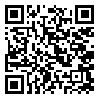BibTeX | RIS | EndNote | Medlars | ProCite | Reference Manager | RefWorks
Send citation to:
URL: http://jhs.mazums.ac.ir/article-1-314-fa.html
Background and purpose:The presence of dyes in wastewaters may cause serious problems for the environment because of their high toxicity to aquatic organisms and unfavorable aesthetical impact. In the present study, multi-walled carbon nanotubes (MWCNTs) were used for removal of anionic dyes Direct Blue 106 (DB106) and Acid Green 25 (AG25), from water samples. Materials and Methods:MWCNTs were oxidized and characterized by Fourier transform infrared spectroscopy (FTIR) and scanning electron microscope (SEM). In batch tests, the effects of various parameters such as pH solution (2.0-7.0), oxidized MWCNT dose (0.01-0.04 g), contact time (7-60 minutes), initial dye concentration (30-350 mg/l), and temperature (25-55° C) were investigated. Results:The optimum pH for removing of investigated anionic dyes from water solutions was found to be 2.0. The adsorption of the dyes reached equilibrium at 15 minutes. Langmuir, Freundlich and Temkin models were used to study the adsorption isotherms and the equilibrium adsorption was best described by Langmuir isotherm model. Kinetic adsorption data were analyzed using pseudo-first-order kinetic model and pseudo-second-order model. The regression results showed that the adsorption kinetics was more accurately represented by pseudo-second-order model. Conclusion:The results suggest that oxidized MWCNT could be employed as an effective material for the removal of anionic dyes from aqueous solutions and the maximum adsorption capacity was found to be 500 and 333 mg/g for DB106 and AG25, respectively.
| بازنشر اطلاعات | |
 |
این مقاله تحت شرایط Creative Commons Attribution-NonCommercial 4.0 International License قابل بازنشر است. |




